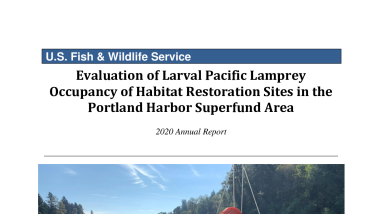Habitat restoration actions focused on the recovery of juvenile Chinook salmon Oncorhynchus tshawytscha are being implemented in the Portland Harbor Superfund area of the Willamette River. These actions may also have effects on co-occurring Pacific Lamprey Entosphenus tridentatus. Use of restored habitats by lampreys, particularly the larval life stage has not been extensively studied. As such, there is a need to monitor the effectiveness of these efforts, in part, relative to larval Pacific Lamprey. Determining the effects of habitat restoration actions on Pacific Lamprey requires evaluation of lamprey occurrence before and after project implementation. Currently, this study is focused on the occupancy of larval Pacific Lamprey and Lampetra spp. in shoreline, confluence, and tributary habitats at five restoration sites being constructed to provide compensation for injuries to natural resources as part of the Portland Harbor Natural Resource Damage Assessment (NRDA): Alder Point, Harborton, Linnton, Triangle Park, and Rinearson. In addition, the study is evaluating the occupancy of lamprey at a non-NRDA site, PGE 13.1, located in a reach of the Willamette River that bisects the city of Portland. In 2019, post-project sampling at restoration sites was conducted at Alder Point and Rinearson and in 2020 post project sample began at Linnton. We also evaluated whether larval Pacific Lamprey occupied corresponding habitats at six reference sites in the Portland Harbor Superfund area (McCarthy Creek, Columbia Slough, Ross Island, Cemetery Creek, Oswego Creek, and Miller Creek). A generalized random tessellation-stratified approach was used to select random, spatially-balanced sample quadrats (30 m x 30 m square) across the lower Willamette River, Multnomah Channel as well as reaches (50 m) in wadeable tributaries. At the Alder Point site, no larval lamprey were detected at the thirty confluence quadrats, the ten slough sites, or the ten shoreline quadrats (detection probability, d, = 0.00 for each). No lamprey were detected in any of the ten confluence quadrats or the ten shoreline and ten confluence quadrats in the newly constructed Linnton restoration site (d = 0.00 for each). At the Rinearson site, one larval lamprey was detected in one of the seven tributary reaches (d = 0.14) and three larval lamprey were detected at one of the 10 confluence quadrats (d = 0.10). At the six reference sites sampled in 2020, larvae were detected at Columbia Slough, Cemetery Creek, Oswego Creek and Miller Creek. A total of 56 larval lamprey were captured and quadrat-specific d ranged from 0.00 to 0.83. This information is being used as part of a long-term evaluation of the effects of habitat restoration on occupancy and distribution of larval lamprey in the Portland Harbor Superfund area.
Publication date
Type of document
Report
Facility
Program
Species
FWS Focus
Ecosystem
FWS and DOI Region(s)




